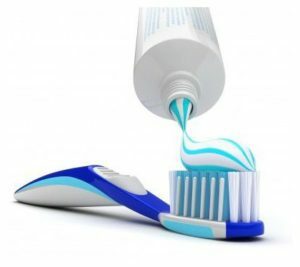 The assortment of toothpastes in shops and pharmacies amazes with its variety. So you want to buy a product that stands out with an unusual color or promises to make your teeth white in just two weeks. Nevertheless, the choice of oral care products should be approached with the mind. The composition of the paste should correspond to the individual features of the dental status, to provide preventive and curative effects.
The assortment of toothpastes in shops and pharmacies amazes with its variety. So you want to buy a product that stands out with an unusual color or promises to make your teeth white in just two weeks. Nevertheless, the choice of oral care products should be approached with the mind. The composition of the paste should correspond to the individual features of the dental status, to provide preventive and curative effects.
The composition of almost all pastes includes several main components:
- Abrasive .Mechanically remove plaque and polish the surface of the teeth.
- Binders .Determine the consistency and stabilize the composition.
- Moisturizing .Prevents the evaporation of moisture from the open package.
- Foaming .Form a foam for more convenient use of the product.
- Sweeteners and fragrances .Give the product a pleasant smell and taste.
- Preservatives .They protect the remedy from the development of microorganisms in it.
In addition to abrasive and polishing particles, whitening pastes use plant-derived enzymes that break down plaque. These include papain and bromelain. Also in such pastes there are oxidants that discolorize the pigment of the plaque.
There are also fluoride-containing pastes - the most common means for preventing caries in adults and children. The effectiveness of this tool in preventing the development of caries is scientifically proven.
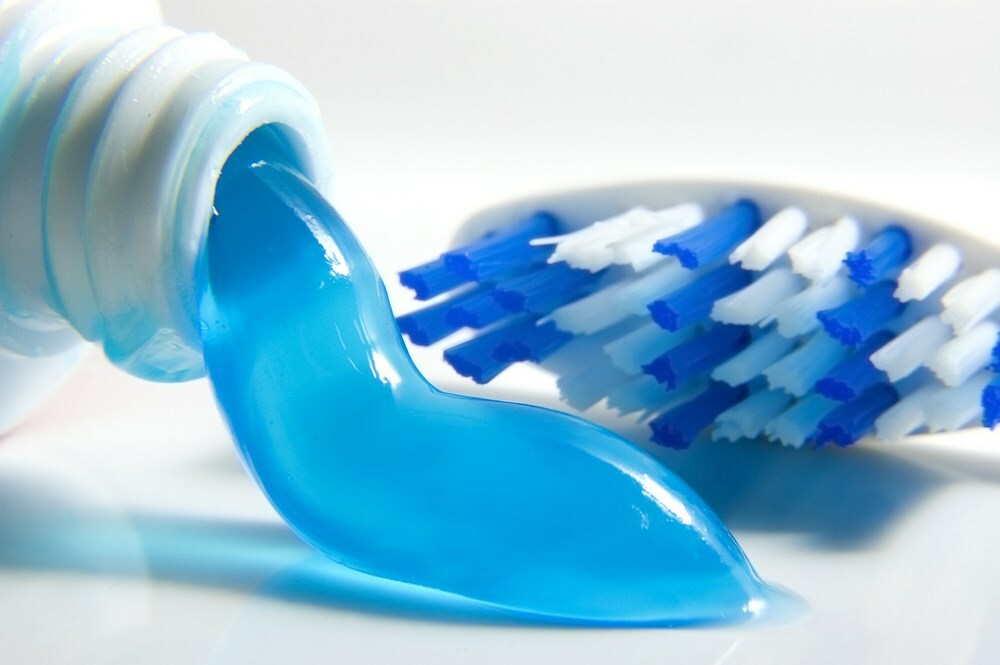
Pastes with calcium salts, strontium, potassium compounds are used to reduce the hypersensitivity of the teeth.
For the treatment of inflammatory periodontal diseases - a complex of tissues surrounding the tooth - pastes with antibacterial and anti-inflammatory components( chlorhexidine, hexetidine, triclosan) are used.
Contents of
- What is Triclosan?
- Where is triclosan contained?
- Antibacterial properties of the component
- Harm of the triclosan for the body
- Disorders of the hormonal background
- Thyroid dysfunction
- Development of heart and vascular diseases
- Destruction of the beneficial microflora
- Weakening of the immune system
- Harm to the development of the fetus
- Poisoning the body
- How to detect the component in the paste?
- Handmade toothpaste
What is Triclosan?
The component was first synthesized in laboratories in Switzerland more than 40 years ago. This substance is chlorine-phenolic nature, which was used as an antibacterial component in personal care products and household chemicals.
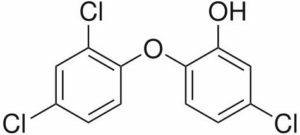
It was also used as an agricultural pesticide for the destruction of pests. For many years, studies and arguments have been conducted about how dangerous a component is for a person.
The substance has antibacterial properties. The spectrum of its antimicrobial activity is extremely wide, the effectiveness of the substance is confirmed by many years of use in dozens of different products. Triclosan is well compatible with other components of hygiene products, including pastes, so the choice of many manufacturers fell on this substance.
The effectiveness of the component is confirmed even when it is used in low concentrations. It destroys bacteria and fungi, has a bacteriostatic and bactericidal effect, affecting the configuration of cytoplasmic membranes of microorganisms. The substance does not cause the formation of colonies of microbes capable of resisting the action of the antiseptic. Its negative property is that it also destroys the beneficial microflora that makes up the natural environment of the human body.
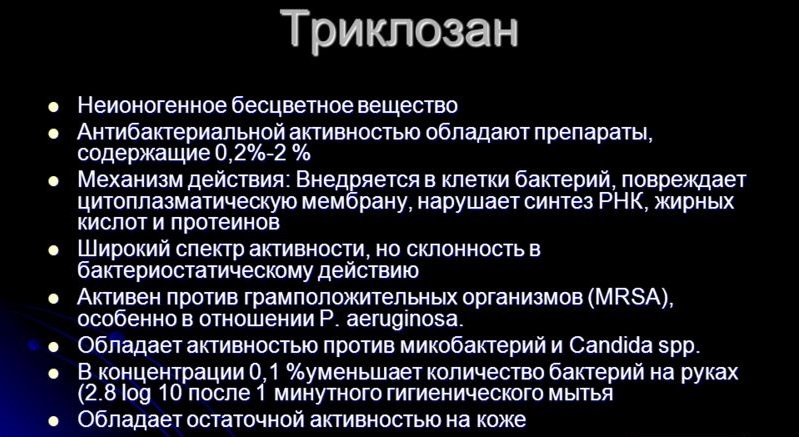
Where is triclosan contained?
This substance contains many personal care products, household chemicals and other everyday things such as:
- toothpastes;
- antibacterial soap;
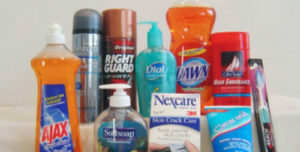
- shower gels;
- shampoo;
- cream;
- washing powders;
- detergent;
- cleaning agents for window and automotive glass;
- fountain pen;
- children's toys.
This is an incomplete list of products in which it can be detected.
Antibacterial properties of component
The parodont consists of a gum, cement covering the root of the tooth, bone tissue of the alveolar process and a ligament that holds the tooth in the bone alveolus. Inflammatory periodontal diseases are most often caused by the action of pathogenic microorganisms.
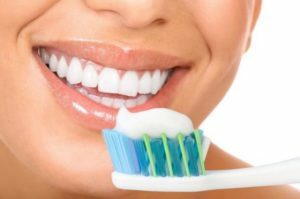 As an antibacterial component, triclosan is used in anti-inflammatory toothpastes to kill microbes that multiply in a hotbed of inflammation. In addition, in the tissues of the body inflammation accumulates specific substances - mediators of inflammation.
As an antibacterial component, triclosan is used in anti-inflammatory toothpastes to kill microbes that multiply in a hotbed of inflammation. In addition, in the tissues of the body inflammation accumulates specific substances - mediators of inflammation.
Normally, they are constantly present in the tissues, but with inflammatory reactions, the concentration of mediators increases dramatically. They increase vascular permeability, which causes redness and swelling around the pathological focus.
Because of the release of the liquid part of the blood from the blood vessels in the tissue, pain occurs, as the exudate compresses the nerve endings. Local and general temperature increase is also a consequence of the work of mediators.
The component inhibits the action of mediators and prevents the development of signs of inflammation. The experiments proved that the use of triclosan agents is effective in case of gingivitis and other inflammatory diseases of the tissues surrounding the tooth.
Harm of triclosan for the organism
It is proved that triclosan, getting into the body, has a number of undesirable effects on various organs and systems.
Breaking the hormonal background
The substance, appearing on the skin in creams and ointments, easily passes through the skin barrier, as it is a fat-soluble substance. He enters the bloodstream and behaves like a female sex hormone estrogen. Such substitution therapy disrupts the hormonal background and leads to cancer of the sex glands in men and women. Children may experience early puberty.
Thyroid dysfunction
Trichlosan metabolism interferes with the normal functioning of the thyroid gland. This gland regulates all types of metabolism, is responsible for the formation of energy and the proper development of the body.
Development of heart and vascular diseases
The component changes the contractility of muscle fibers, including the main muscle in the body - the heart muscle.
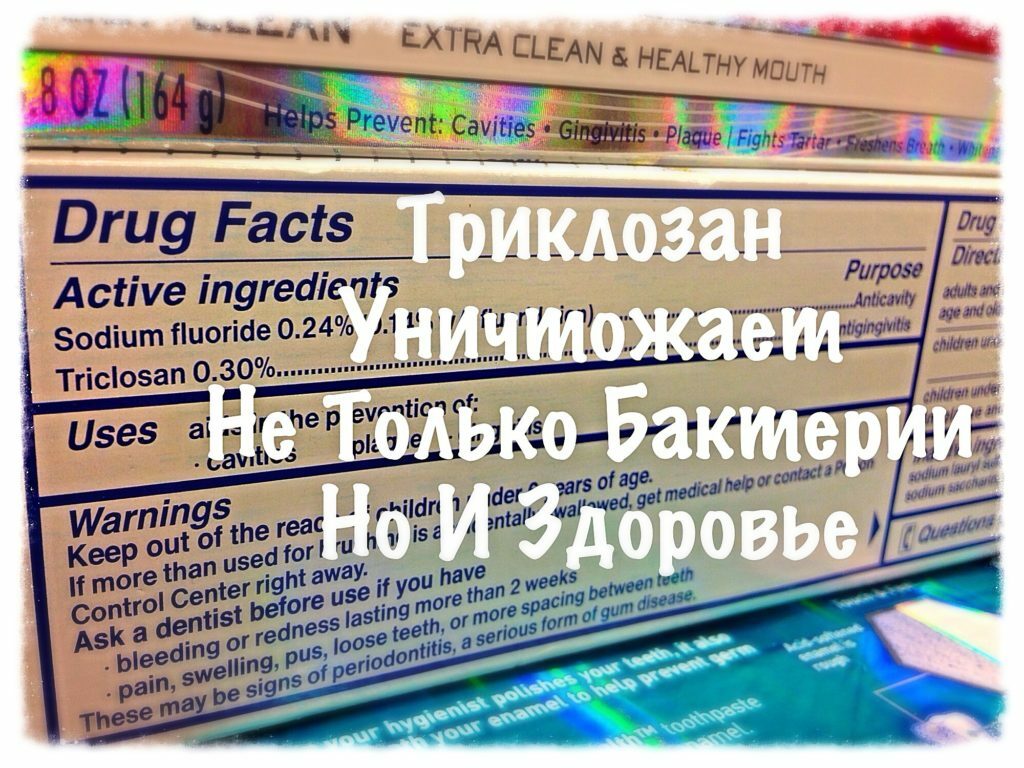
Destruction of useful microflora
The component acts both on pathogenic forms, and on the resident microflora of the body. Useful bacteria, necessary for a balanced internal environment, die from the action of the substance.
Weakening of the immune system
To form a strong immune system, the body must face natural "dirt".The immune system will then activate its defense systems and produce antibodies. People who have been using personal hygiene products since childhood with antibacterial components are more prone to infectious diseases, since their immunity does not produce sufficient resistance to environmental factors.
For prolonged exposure, pathogenic bacteria produce resistance or resistance to the substance. With the development of an infectious disease in the body, the treatment of which requires the intake of antibiotics, microorganisms may exhibit the same resistance, and therapy will prove ineffective.
Harm to fetal development
According to some studies, triclosan negatively affects fetal health in the womb. It reduces the flow of blood to the brain of the fetus, which leads to an oxygen deficiency of the organ, and from this follows a disruption of its development.
Poisoning the body
By interacting with tap water, the substance combines with chlorine. As a result, special compounds are formed - dioxides, which are absorbed into the blood and exert a toxic effect on the body.
In addition to directly affecting the human body, triclosan, getting into the environment with water, pollutes water and soil, and poisons plants and animals.
In Russia you can easily purchase funds with this substance. However, the US authorities in 2016 issued a ban on the sale of soap, containing as an antibacterial component of triclosan. The ban does not apply to other means, including pastes.
How to detect a component in a paste?
The presence of a component in the media can be detected by reading the composition of the product. It will be designated as "triclosan" or "triclosan".
Here are some names of toothpastes with triclosan in the composition: 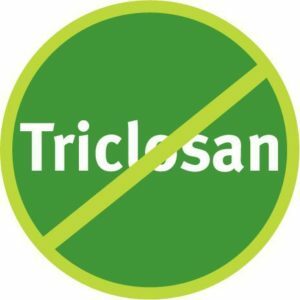
- Colgate Total with triclosan in a concentration of 0.3%;
- Aquafresh;
- President Active.
Another antiseptic agent used in hygiene products is chlorhexidine, a biguanide derivative. It prevents the attachment of pathogenic microorganisms to tooth enamel. The negative side is that long-term use of drugs containing this compound can also lead to dysbiosis. In addition, chlorhexidine stimulates the formation of a stone on the surface of the teeth.
Manufacturers offer many pastes, in which instead of triclosan and other aggressive compounds in the role of antibacterial agents are natural plant components. These include extracts of eucalyptus, thyme, tea tree, sage, and propolis.
Examples of toothpastes without triclosan in the composition:
- Colgate Propolis;
- Elgidium with chlorhexidine;
- President Exclusive with hexitidine, thyme extract and propolis.
Handmade toothpaste
Those who do not trust manufacturers and do not want to purchase hygiene products in stores can always prepare an oral care product at home. Home-made paste is not guaranteed to contain hard antibacterial and other aggressive ingredients. There are many recipes for such homemade pasta. Here are some of them:
- Pasta with sea salt .To prepare a fragrant and useful mixture, you need to mix a pinch of fennel powder and ground sea salt, 1/3 teaspoon cinnamon, 2 teaspoons baking soda and 4 drops of tea tree oil. It is necessary to add to the resulting mass of 1 teaspoon of coconut oil, when it's time to brush your teeth.
- Of white clay .Making a paste of white clay, you want to mix 60 grams of clay with water to get a thick mass. In this mass, you need to add 2-3 drops of chamomile and sage oil, 1 teaspoon of honey and 7 drops of propolis, then carefully mix the ingredients.
- With wood ash .As for the cleaning of teeth, wood ash can be used, but it must be mixed with ordinary paste. Ash has bleaching and absorbing properties, because it contains potassium hydroxide. Therefore, such a tool should not be used more than once a week.
Like any medicine, triclosan can be both a poison and a curative, it all depends on its concentration. Studies have shown that the use of a paste with a component for two weeks did not affect the composition of normal microflora of the oral cavity and the resistant properties of pathogenic microorganisms.
Reasonable use of the component by industrial activities and careful approach to the selection of funds by ordinary citizens will prevent the negative impact of the substance on health. Thanks to modern chemical science, analogues can be created that will not yield to or even surpass triclosan in efficiency, and the harmful effect will be reduced to zero.
